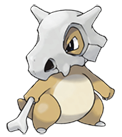Cubone

| |||
| The Lonely Pokémon | |||
| #104 - Cubone | |||
| Evolve | Marowak | ||
| Debut | Pokémon: Red Version Pokémon: Green Version | ||
| Species Info | |||
| Type | |||
| Height | 0.4 m (1'04") | ||
| Weight | 6.5 kg (14.3 lbs.) | ||
| Color | Brown | ||
| Gender Ratio | 1♂ : 1♀ | ||
| Ability | Rock Head / Lightningrod | ||
| Hidden Ability | Battle Armor | ||
| Egg Group | Monster | ||
| Icon | Sprite | ||
| File:104sprite.png | |||
| Footprint | |||
| 30px | |||
| Base Statistics | |||
| Hit Points | 50 | Speed | 35 |
| Attack | 50 | Sp. Attack | 40 |
| Defense | 95 | Sp. Defense | 50 |
| Training Info | |||
| Catch Rate | 190 | Hatch Steps | 5,120 |
| Base Exp. | 087 | Effort Points | Def |
| Happiness | 70 | ||
| To Lv.100 | Normal | ||
| Kanto # | Johto # | Hoenn # | Sinnoh # |
|---|---|---|---|
| < 104 > | < 203 > | [[{{{4p}}}|<]] 208 [[{{{4n}}}|>]] | |
| Unova # | Johto (IV) # | ||
Cubone is a bone-wielding Pokémon that was introduced in the first generation games. Its evolved form is Marowak.
Information[edit]
Cubone is a Pokémon that wears the skull of its dead mother on its head. As it always wears the mask, its true face has never been seen. It is known to cry when it is lonesome and when it thinks of its dead mother, such as when it sees her likeness in the full moon, with its crying making the skull rattle hollowly. A Cubone's skull echoes through the skull and comes out as a sad melody.
It is said that Cubone lose their mothers after birth, although the cause of this is never elaborated upon. There is one instance within the first generation games where a Cubone at Mr. Fuji's house had a mother, a Marowak, that was just recently killed by Team Rocket, and its ghost resided in Pokémon Tower. As this Marowak was murdered after the Cubone was born, it raises some doubt as to whether female Cubone and Marowak die in childbirth.
In addition to the skull which it dons, a Cubone also wields an unspecified bone as a club in combat. Cubone evolves into Marowak at Level 28.
Appearances[edit]
Mainstream Games[edit]
In Pokémon: Red, Blue, Yellow, FireRed and LeafGreen, they appear rarely at Pokémon Tower. They also appear at the Safari Zone in Yellow and at Sevault Canyon in FireRed/LeafGreen.
In Gold, Silver, Crystal, HeartGold and SoulSilver, Cubone are uncommonly found at Rock Tunnel. Cubone can also be purchased at the Goldenrod Game Corner for 800 coins in Crystal, and in HeartGold/SoulSilver they also appeared at the Safari Zone's Desert area.
In Diamond, Pearl and Platinum, Cubone appeared at Route 203 during swarms.
Other Games[edit]
In Pokémon Pinball, Cubone was found at Lavender Town. Cubone appeared in Pokémon Channel outside the Ruins of Truth on clear and cloudy mornings and days. In Pokémon Trozei!, they appeared at Endless Level 11, Forever Level 11, Pair Trozei and Mr. Who's Den. In Pokémon Mystery Dungeon: Red and Blue Rescue Teams, Cubone was featured as one of the potential starter Pokémon which the player would be turned into for the entire game depending on how they answered the personality quiz, and other Cubone could be recruited at the fifth through tenth floors of Southern Cavern.
In Pokémon Mystery Dungeon: Explorers of Time and Darkness, Cubone could be recruited at the first seven floors of Northern Desert. Cubone also appeared in Pokémon Rumble at Eternal Tower.
Other Appearances[edit]
Other Games[edit]
- In the Super Smash Bros. series, Cubone made a cameo appearance among a crowd of Pokémon in the intro sequence of Super Smash Bros. Melee, and it also makes a background cameo in the Ground phase of the Pokémon Stadium 2 level, as seen in Super Smash Bros. Brawl, Super Smash Bros. for Wii U and Super Smash Bros. Ultimate. Cubone has also been represented by a trophy in Brawl and a Novice-rank Primary Spirit (which comes with a weakness against water). When fought against in a Spirit battle, Cubone's Spirit would possess Wolf O'Donnell in a match where boomerangs would appear commonly.
Other Media[edit]
- In the Pokémon anime, a Cubone was initially featured as the Pokémon of Giselle, a trainer at a Pokémon trainer's school. Ash's Pikachu was able to overcome type disadvantage to defeat it in a battle. In addition to minor appearances throughout the anime, Cubone have also appeared in some of the Pikachu shorts, in one case being part of a gang harassing Pikachu's friends, and in another instance playing drums in Meowth's band.
- In the Pokémon Adventures manga, a Cubone was briefly shown belonging to a Pewter Gym trainer during the Red/Green/Blue arc. A Cubone was later shown as part of Crystal's team and specialized in projectile attacks.
Trivia[edit]
- Its name seems to be a combination of either cute (which would comment upon its appearance and young age), cub (which also would reflect that Cubone is young) or cue ball (which could refer to the way it uses its bone) with "bone".
- Pages with broken file links
- Creatures
- Pokémon
- Ground Type Pokémon
- Brown Colored Pokémon
- Rock Head Ability Pokémon
- Lightningrod Ability Pokémon
- Battle Armor Ability Pokémon
- Monster Egg Group Pokémon
- Pokémon that yield Def Points
- Pokémon with catch points
- Pokémon with hatching steps
- Pokémon with exp base
- Pokémon with happiness base
- Pokémon with Lv 100